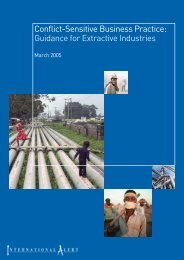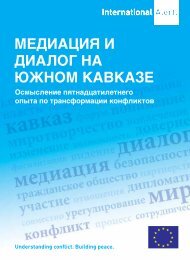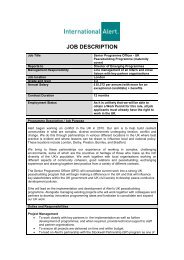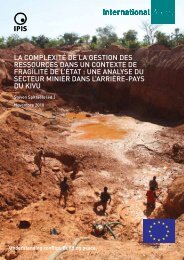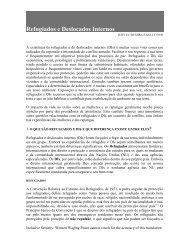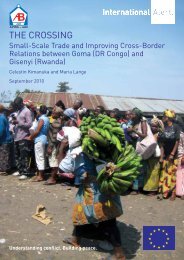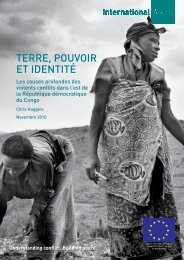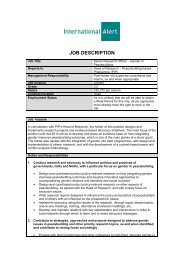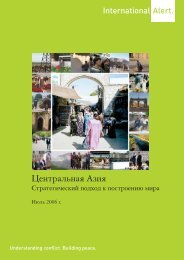What peace and Whose? - Internal Displacement Monitoring Centre
What peace and Whose? - Internal Displacement Monitoring Centre
What peace and Whose? - Internal Displacement Monitoring Centre
You also want an ePaper? Increase the reach of your titles
YUMPU automatically turns print PDFs into web optimized ePapers that Google loves.
22 International Alert4. Conclusions <strong>and</strong> recommendationsThis report began by asking what <strong>peace</strong> in South Sudan <strong>and</strong> Sudan is, <strong>and</strong> how might it be madebetter – in particular, be made more comprehensive, more stable <strong>and</strong> more lasting. Another wayof putting these questions is to ask what it means to build <strong>peace</strong> in South Sudan <strong>and</strong> Sudan.Evidently, as things are in South Sudan <strong>and</strong> Sudan today, a better <strong>peace</strong> is possible. For anySudanese who today or in the recent past has been living with the reality of violence <strong>and</strong> fighting– in Abyei, Blue Nile, Darfur, South Kordofan, Jonglei, Lakes, Unity, Warrap <strong>and</strong> elsewhere –a more comprehensive, more inclusive <strong>peace</strong> still needs to be built. For any Sudanese who isliving with an ongoing <strong>and</strong> embittering experience of discrimination, injustice, inequality or otherfactors of conflict, a stronger <strong>peace</strong> needs to be built.One starting point for people in each country to address this reality <strong>and</strong> challenge is to startdiscussing what kind of <strong>peace</strong> they experience at present <strong>and</strong> what kind of <strong>peace</strong> they want for thefuture. To start a process of discussion about this does not require jettisoning current priorities,although it may challenge individual groups’ priorities <strong>and</strong> short-term aims. However, it doesrequire initiative <strong>and</strong> action, in particular, to:• Listen to a wider range of fellow citizens;• Recognise the shortcomings of the current <strong>peace</strong>;• Learn from what has been done elsewhere;• Nurture the belief that another kind of <strong>peace</strong> is possible – a more comprehensive, moreinclusive <strong>and</strong> more stable <strong>peace</strong>.Given the aspirations which leaders in South Sudan <strong>and</strong> Sudan have sometimes voiced about<strong>peace</strong>, <strong>and</strong> the ongoing threats <strong>and</strong> risks to future <strong>peace</strong> in the two countries, it is surely now timefor people in each country to work together towards a more inclusive <strong>and</strong> more stable <strong>peace</strong>.Based on Alert’s research in South Sudan <strong>and</strong> Sudan, <strong>and</strong> on our experience in other <strong>peace</strong>buildingcontexts, we make three broad recommendations to those in South Sudan <strong>and</strong> Sudan who areconcerned to build a more comprehensive, more stable <strong>peace</strong>, <strong>and</strong> to those in the internationalcommunity who are concerned to support their efforts.• Use a positive <strong>peace</strong> framework to define goals <strong>and</strong> measure progress. Peacebuilding initiativesin South Sudan <strong>and</strong> Sudan have in the past tended to focus on issues connected with theimplementation <strong>and</strong> sustenance of formal <strong>peace</strong> agreements, or on grassroots inter-communaldialogue. However, <strong>peace</strong> agreements tend to skate around difficult issues underlying conflict,<strong>and</strong> grassroots initiatives, though highly important, are too small to make a wider impacton those issues. Therefore <strong>peace</strong>building in both countries needs to be framed much morebroadly, connecting the national with the local <strong>and</strong> aiming for a fuller, more positive <strong>and</strong>inclusive <strong>peace</strong>. To be successful, <strong>peace</strong>building should use a framework of positive <strong>peace</strong>,which will highlight what changes in institutions, attitudes <strong>and</strong> behaviours will bring about astronger <strong>and</strong> more comprehensive <strong>peace</strong>, rather than simply containing the conflicts of today.• Promote a visioning <strong>and</strong> sustained dialogue process about <strong>peace</strong>. A sustained dialoguebetween the state <strong>and</strong> the citizen, <strong>and</strong> between citizens – between power, politics <strong>and</strong> society– can help to bring about changes <strong>and</strong> progress towards a more comprehensive <strong>peace</strong>. Such aprocess is possible if initiated <strong>and</strong> developed with due care. An inclusive process of dialogue,





